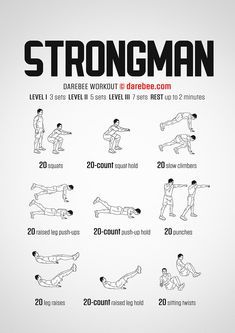Adding variety to your training routine is essential for developing a well-rounded athlete. Strongman training programs offer an excellent way to build strength, improve endurance, and enhance overall athletic performance. Combining elements of powerlifting, Olympic weightlifting, and functional movements, strongman training challenges the body in unique ways, promoting muscular development, mental toughness, and improved athleticism.
The Basics of Strongman Training
Strongman training is a type of strength training that focuses on functional movements involving everyday objects, such as logs, tires, sandbags, and atlas stones. These exercises simulate real-life activities and help athletes develop real-world strength.
Unlike traditional weightlifting, strongman training doesn’t revolve around fixed barbells and machines. Instead, it utilizes odd-shaped and heavy objects, requiring athletes to engage multiple muscle groups simultaneously, enhancing coordination, stability, and overall power.
Benefits of Strongman Training
1. Strength Development: Strongman training is renowned for building tremendous strength due to the demanding nature of the exercises. Lifting and carrying awkward objects challenges the muscles and stimulates significant muscle growth, leading to increased overall strength.
2. Improved Functional Strength: The functional aspect of strongman training carries over to everyday activities. The movements involved translate directly to real-life scenarios, making athletes more capable of tackling any physical challenge they may face.
3. Enhanced Cardiovascular Endurance: Engaging in strongman training programs elevates the heart rate and increases overall cardiovascular endurance. The combination of heavy lifting and intense conditioning seamlessly improves both muscular and cardiovascular systems.
4. Mental Toughness: Strongman training pushes athletes to their limits both physically and mentally. The unpredictable nature of the exercises requires mental toughness, fortitude, and resilience, building a stronger mindset in athletes.
Components of a Strongman Training Program
1. Carries and Drags: Incorporating exercises like farmer’s walks, yoke carries, and sled drags mimic real-world situations where you have to move and transport heavy objects. These exercises strengthen your grip, upper and lower body, and improve overall coordination.
2. Loading and Unloading: Atlas stone lifts, sandbag carries, and keg lifts work on explosiveness and full-body strength. These exercises target your core, back, legs, and arms, providing a comprehensive strength training experience.
3. Overhead Pressing: Log presses, axle presses, and circus dumbbell exercises focus on developing shoulder stability and strength. Strongman implements require athletes to lift weights overhead, challenging the upper body and core muscles.
4. Functional Movements: Tire flips, rope climbs, and truck pulls engage the entire body, developing power, strength, and coordination across various muscle groups. These exercises closely mimic real-life situations, making them invaluable for overall functional strength.
Tips for Strongman Training
1. Start Slowly: It is crucial to start strongman training with lighter loads and progressively increase the intensity and weight as your strength and technique improve.
2. Prioritize Technique: Proper form and technique are essential in strongman training. Seek guidance from experienced trainers or coaches to ensure you are performing exercises correctly, reducing the risk of injury.
3. Consistency is Key: To achieve optimal results, commit to regular training sessions and follow a consistent strongman program. Dedication and perseverance will yield significant improvements in strength and athleticism.
4. Recovery and Rest: Strongman training is intense and places high demands on your body. Allow ample time for recovery and ensure you get enough quality sleep and proper nutrition to support muscle growth and repair.
Conclusion
Strongman training programs offer a unique approach to strength and conditioning, creating well-rounded athletes. By integrating functional movements and challenging exercises, individuals can cultivate strength, endurance, mental resilience, and overall athletic performance. Whether you are an elite athlete or a recreational fitness enthusiast, incorporating strongman training into your routine can unlock your true potential and transform you into a stronger, more capable individual.
